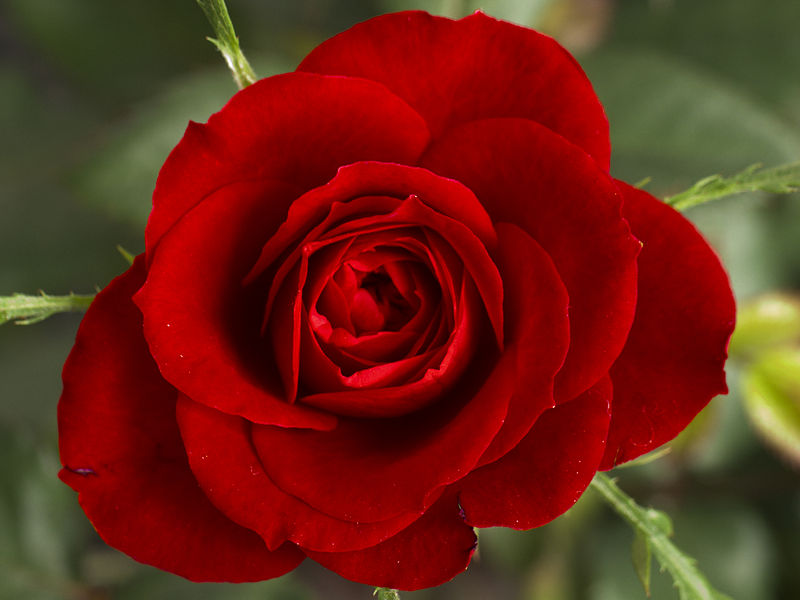
Russian version - click here
Image - a small red rose from Wikimedia
The introducing or rose alcohols to the first rose formula, hopefully made it softer, more floral and more rosy. But may be also more citronella like – depends on the quality of the rose alcohol used. There are some other important aromachemicals that might give this rose a finishing touch.
Rose oxide – is a very important aromachemical. Naturally less that 0.5% of this chemical can be found in a rose oil, but because our nose is 80 times more sensitive to it compared to citronellol, the influence of Rose oxide is comparable to that of citronellol. Commercial product consists of different isomers and may vary in purity grades. If you smell it even in 10% dilution you probably never link this gassy smell to a rose. Books says that the rose or geranium like odour can be noticed by extreme dilution or when used in a rose accord in low concentrations. The change rose oxides makes to a rose accord is subtle but noticeable. Use 0.5% or less in the rose accord and try to smell the difference.
Rose crystals or Rosone – is an nice fixative for a rose. It has a very difficult chemical name – trichloro methyl phenyl carbinyl acetate that you can find in some rose formulae. Also known as Rosatol, Rose acetale, TCMBA (guess where this comes from), Rosacetate, Rosalina etc. This one has a weak rosy odour with green nuances. It smells like “another variant of PEA” and you tend to underestimate this material as at first it may seem to have little or no influence to the rose compositions. The best is to compare the smell of pure PEA with a smell of PEA with 5% of Rose crystals added. Comparing two smelling strips I found that Rosone enriches the smell of PEA making the rosy smell more prominent and powerful. So, 2-4% of the rose crystals in the formula can give power to the rose and make it more long lasting. As I already have mentioned before – Vetiver oil, Guaiacwood oil and Cedarwood oil may also be used as fixatives in rose accords.
Beta-Damascenone – another very important rose chemical. Naturally it occurs in a rose oil at about 0.14% concentration. But the human nose is 55 times more sensitive to beta-damascenone compared to the rose oxide. Or 4400 times compared to citronellol. Thus, beta-damascenone makes almost 70% of the rose smell. This is an expensive aromachemicals that restricts it use in perfumery. You don’t find it in often in the rose formulae. A similar aromachemical Damascone (especially beta) may also be used, but it’s still expensive. It has a pleasant fruity floral odour recalling the smell of plum or a bit blackcurrant. I never compared damascones and damascenones, so, I don’t know if beta-damascone reaches the same effect in a rose as beta-damascenone, but 0.05 – 0.3% of it brings a nice fruity nuance to a rose accord.
Aldehydes and alcohols – waxy fatty notes of aldehydes finishes the top note of the rose smell giving some nuances of fatty rose petals of the fresh flower. Different aldehydes or alcohols might be used for that purpose (C8 – C12) in concentration of 0.01 – 0.2%.
Rosalva – is an unsaturated alcohol with ten carbon atoms (but don’t confuse it with Alcohol C10). This is an aromachemical with a rosy odour and fatty waxy nuances. Good to combine with aldehydes. To my nose possesses a harsh metallic note, but I haven’t found it back in a rose accord. Nice finishing touch to a rose.
Green notes – are also very common in rose accords. The simplest two are the leaf alcohol (cis-3-hexenol) and PADMA (Phenyl Acetaldehyde Dimethyl Acetal). The first one has a green fresh smell of a grass and the second one recalls a more sharp radish-like smell of arugula (rucola, rocket). One of them or both can be used to give some fresh nuances of green notes. Leaf alcohol is stronger than PADMA and should be used in lower concentrations – 0.1-0.3% for leaf alcohol and 0.2-1% for PADMA.
Naturals – are the best enhancers of almost any perfume. Rose oil and absolute are widely used in the rose accords. But a cheaper Geranium or Palmarosa oil is also a common natural constituent in a rose formula. Should be used up to 1-2%. Sometimes less sometimes more.
Well now our rose formula consists from about 15 ingredients. And this is a nice number for a good rose base. Enough space to play. Enjoy!



2 opmerkingen:
A rosey kiss to you for sharing this with us!!!!
Simone
Thank you Simone,
Rose scented greetings and hugs to you too. It's nice to hear that there are more people interested in a know how it's made of perfumery as well as perfumery images and visions :o)
Een reactie posten